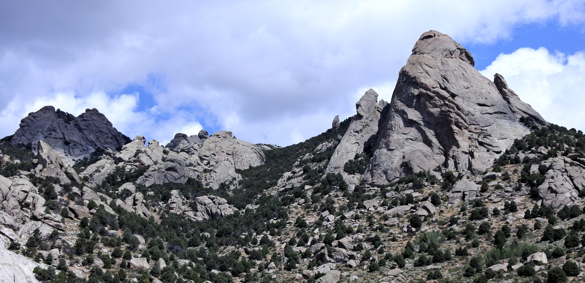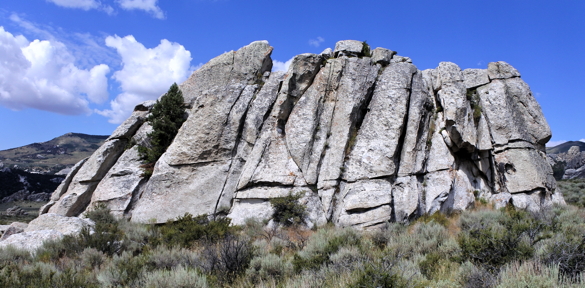 Gloria and I traveled out west this summer to see family and a bit of scenery. Of course, geologists are always looking for geological attractions, and we found a delightful one at City of Rocks National Reserve in southern Idaho. We visited this granite wonderland with my parents, Gary and Corinne Wilson. The weather was perfect and the rocks spectacular. Above is a view of Granite Peak on the left and Steinfells Dome on the right.
Gloria and I traveled out west this summer to see family and a bit of scenery. Of course, geologists are always looking for geological attractions, and we found a delightful one at City of Rocks National Reserve in southern Idaho. We visited this granite wonderland with my parents, Gary and Corinne Wilson. The weather was perfect and the rocks spectacular. Above is a view of Granite Peak on the left and Steinfells Dome on the right.
 The City of Rocks (great name!) is along the California Trail of the 19th Century. Its distinctive geology is described in many emigrant journals, and several travelers left their names smeared in axle grease on some of the overhanging granite outcrops. These inscriptions are at Camp Rock.
The City of Rocks (great name!) is along the California Trail of the 19th Century. Its distinctive geology is described in many emigrant journals, and several travelers left their names smeared in axle grease on some of the overhanging granite outcrops. These inscriptions are at Camp Rock.
 The granite overhangs provide shelter for hundreds of mud nests constructed by American Cliff Swallows. Note the baby peeking out on the left.
The granite overhangs provide shelter for hundreds of mud nests constructed by American Cliff Swallows. Note the baby peeking out on the left.
 There are two granites present in the City of Rocks reserve. Above is the porphyritic Green Creek granite, part of the Green Creek complex of granite, gneiss, and schist that is Archean in age, an astounding 2.5 billion years old. This is one of the oldest rocks exposed in the United States. The term porphyritic means there are large crystals interspersed with small crystals. The visible white crystals here are potassium feldspar. (Dr. Meagen Pollock, Wooster’s petrologist, will be very proud of me.)
There are two granites present in the City of Rocks reserve. Above is the porphyritic Green Creek granite, part of the Green Creek complex of granite, gneiss, and schist that is Archean in age, an astounding 2.5 billion years old. This is one of the oldest rocks exposed in the United States. The term porphyritic means there are large crystals interspersed with small crystals. The visible white crystals here are potassium feldspar. (Dr. Meagen Pollock, Wooster’s petrologist, will be very proud of me.)
 Above is the Almo Granite, which has a more even grain size distribution. It was intruded into the Green Creek Complex only around 28 million years ago.
Above is the Almo Granite, which has a more even grain size distribution. It was intruded into the Green Creek Complex only around 28 million years ago.
 Here is a contact of the Almo Granite above and the Green Creek Complex granite below, with my Dad’s arm for scale. This is the igneous equivalent to an unconformity, with an almost 2500 million year difference in age between the two rocks.
Here is a contact of the Almo Granite above and the Green Creek Complex granite below, with my Dad’s arm for scale. This is the igneous equivalent to an unconformity, with an almost 2500 million year difference in age between the two rocks.
 A closer view of the contact. The angled dikes in the unit below are made of fine-grained quartz and feldspar, a mix called aplite.
A closer view of the contact. The angled dikes in the unit below are made of fine-grained quartz and feldspar, a mix called aplite.
 The Almo Granite shows a peculiar kind of weathering called tafoni. The outer surface of the rock acquires a resistant crust through weathering, a process called case-hardening. Apparently in this case the hardening is due to the dissolution of silicate minerals, which reprecipitate as hard silica-rich minerals. The softer rock underneath is then dissolved by salty water (the salt probably coming through dust blown from evaporative salt flats), resulting in small cavities and caves like the one above.
The Almo Granite shows a peculiar kind of weathering called tafoni. The outer surface of the rock acquires a resistant crust through weathering, a process called case-hardening. Apparently in this case the hardening is due to the dissolution of silicate minerals, which reprecipitate as hard silica-rich minerals. The softer rock underneath is then dissolved by salty water (the salt probably coming through dust blown from evaporative salt flats), resulting in small cavities and caves like the one above.
 The tafoni and case-hardening is also visible in this Green Creek granite outcrop.
The tafoni and case-hardening is also visible in this Green Creek granite outcrop.
 The case-hardened layer can slip off rounded surfaces through exfoliation of the granite domes, sometimes leaving a small resistant remnant on the very top. These remnants are called pickelhauben because of the resemblance to the spiked World War I German helmets. This monolith is termed, in fact, Kaiser’s Helmet.
The case-hardened layer can slip off rounded surfaces through exfoliation of the granite domes, sometimes leaving a small resistant remnant on the very top. These remnants are called pickelhauben because of the resemblance to the spiked World War I German helmets. This monolith is termed, in fact, Kaiser’s Helmet.
 Another distinctive form of chemical weathering of the granite produces panholes. These have flat bottoms rather than the rounded bottoms of potholes.
Another distinctive form of chemical weathering of the granite produces panholes. These have flat bottoms rather than the rounded bottoms of potholes.
 Dr. Shelley Judge, Wooster’s structural geologist, will love the joints visible in this granite body. Joints are fracture sets along which there is no movement (thus they are not faults). The joints here are complex and probably related to thermal contraction as the granite pluton slowly cooled underground.
Dr. Shelley Judge, Wooster’s structural geologist, will love the joints visible in this granite body. Joints are fracture sets along which there is no movement (thus they are not faults). The joints here are complex and probably related to thermal contraction as the granite pluton slowly cooled underground.
 This is my favorite monolith in the reserve. It shows a combination of the spherical exfoliation of the granite dome and a consistent set of joints cutting through it.
This is my favorite monolith in the reserve. It shows a combination of the spherical exfoliation of the granite dome and a consistent set of joints cutting through it.
 Joints dominate the Almo Granite exposed at our picnic site.
Joints dominate the Almo Granite exposed at our picnic site.
 Finally, the granite outcrops at City of Rocks National Reserve are a famous destination for rock climbers. In the center here is one of the best-known climbing sites, Morning Glory Spire. At the tippy top you might be able to see two climbers standing there enjoying the view and their accomplishment.
Finally, the granite outcrops at City of Rocks National Reserve are a famous destination for rock climbers. In the center here is one of the best-known climbing sites, Morning Glory Spire. At the tippy top you might be able to see two climbers standing there enjoying the view and their accomplishment.
Thank you to my parents for suggesting this trip (and Dad for driving). It is a geological paradise, even if there isn’t a fossil for miles.



Once you get the ignorant geology bug it’s hard to go back to being a sedentary geologist.
I love this post. And I am so proud of you!